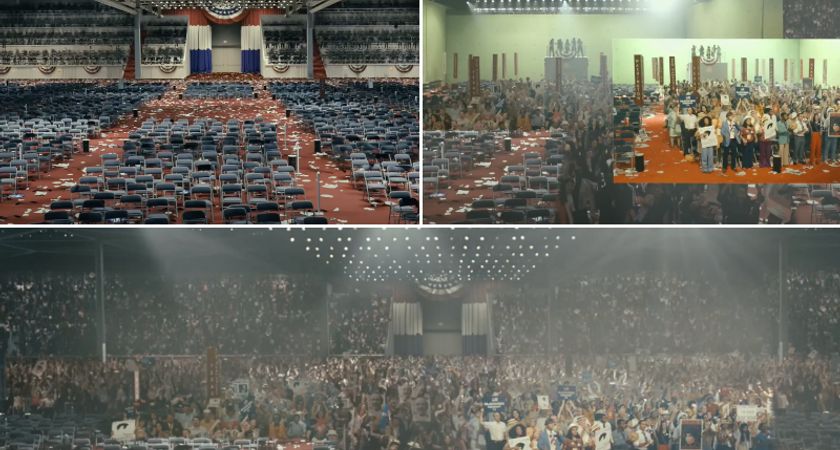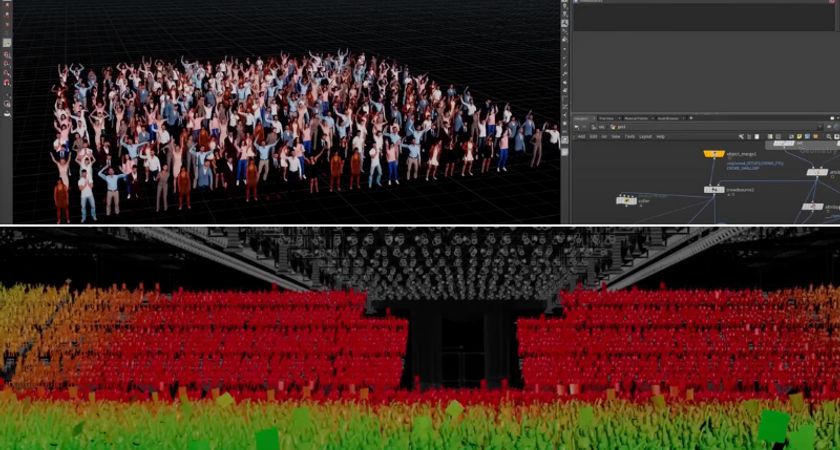Have you ever wondered how television shows and movies add in those extra visual effects that take a scene to the next level? In the case of Emmy-nominated television series Mrs. America, the team working at visual effects studio Folks VFX were responsible for some of the amazing work done in the series- a team that included none other than five of our very own Centennial graduates! Set in the 1970s, Mrs. America tells the story of the movement to ratify the Equal Rights Amendment and includes big name stars like Cate Blanchett and Rose Byrne, to name a few. One of the scenes within the series includes the recreation of the 1972 Democratic National Convention. Although it appeared that there were thousands of people within the crowd, it actually consisted of some extras and a green screen, while the rest was up to the visual effects team. To get a better idea of the work involved, check out the video below:
Leonardo Silva, CG Supervisor at Folks VFX, who happened to be the CG Lead at the time while working on Mrs. America, says, “My task was to recreate the lighting in the stadium. I made a lighting rig HDA that was able to be deployed and controlled when needed. We used it for all the stadium shots and it allowed us to have consistency between every scene regardless of where the camera was facing in the stadium. I have recently been promoted to CG Supervisor, and now work intimately with the CG team here in Toronto. We work closely with Folks Montreal and collaborate frequently on many projects, sharing techniques, ideas and workflows across our offices.” Teaching at Centennial for many years, Leonardo was able to work on the project along with Laurence Cymet, CG Supervisor at the time, who also happens to be an instructor at Centennial. “We had access to selecting a group of students we felt would be a great fit for us at Folks,” Leonardo says.
Working on this project was a group effort amongst the twelve CG artists. “The Centennial grads were great to work with; they took direction well and learned quickly. It was critical to be able to have them jump into a live production and be able to adapt and take direction as things changed quickly,” Leonardo explains. To get an idea of the specifics involved in this project, Leonardo details some of the work done and the types of roles many team members had:
“Houdini and Maya were our main 3D packages and Arnold was our render engine of choice for Mrs. America. We used them for our crowd setup, scene assembly, fx elements and to light and render our shots. Our models were modelled in Maya and shaded in Substance. These assets would then be setup in Houdini for all the shots. We deployed a procedural system of point instances in Houdini for pretty much everything in the stadium, for example, the stadium structures, lights, props, garbage scattered on the floor, and the chairs the crowd would sit on. The crowd setup relied heavily on these points to guide where the agents would be placed in the stadium. This allowed us to react to client changes quickly, by changing the points and everything would follow. In turn allowing us the ultimate flexibility to experiment and explore quite quickly.
Each artist had a role to play in our production, from generating an accurate architectural stadium environment to applying the materials that made it look and feel real. We were able to light the stadium giving it that 1970's era and feel just like the real women's rights movement. We relied heavily on a lot of historical images and video references allowing us to closely match the stadium layout, where the people sat, what they wore etc. Back then, people were allowed to smoke indoors, making the air quite saturated with smoke. This gave the scenes a real sense of atmosphere, allowing for light play and a sense of character in the stadium environments.

Steve Kahwati was our crowd master; he created the crowd setup you see on all our stadium shots in Mrs. America. The setups were quite complex with hundreds of animation cycles, that were parsed based on what the digital crowd performance needed to be for a given shot. We were able to place agents anywhere we wanted using our point instancing setup. With this system we were able to place agents on chairs, have them walking or hanging out in the isles. A lot of them were cheering and holding up signs as well that had to match to the existing live action plates. Ryan Ng set up a very clever camera culling frustum tool, that would map out the spatial movement of the real plate camera allowing us to delete crowd agents that were not visible outside of the camera field of view. This was a very powerful way to speed up how we loaded our scenes, and it greatly reduced our render times in the end.
The stadium was very intricate in its architecture. André Ko modelled the stadium from photographs and Alex Avdyushin was responsible for texturing it and shading in Substance. Michael Deng modelled lots of garbage and debris that we found on the reference photos, of the stadium floor. Mark Lazlo setup a very neat procedural spot light rig that allowed us to aim our CG spot lights to match to the plate ones for our volumetric passes for the stadium. Daniel Kachuki helped us with buses, trees and the outside of the stadium. We had a couple of other shots that were really beautiful as well. There was a cg deer in the story and Igor Avdyushin was responsible for the deer textures, fur grooming and lookdev. Also, the exterior of the White House lawn and estate was created and it was a team effort by Alex Avdyushin (layout, lookdev, textures) and Mark Lazlo (lighting).
None of these shots would have looked as great without our tracking and layout team of Shadat Patwary, Manjeet Singh and Shevina Valentina.”

Overall, the team produced seamless work that contributed to successful storytelling within the series. “The Centennial grads were great additions to our CG team. They were able to help us make all the moving pieces work for our large volume of shots. For me good VFX should be invisible, one should not know anything was done to the shot, allowing the viewer to be immersed in the story and the cinematography of the show. The key to being able to do this so well is having a combination of great CG elements and seamless integration with the live action, something our talented comp team did so well. I feel we succeeded in doing just that, our work was seamless allowing the viewer to merge with the importance of the women's rights movement and its impact in our history,” Leonardo says.
We are so incredibly proud of our talented graduates who contributed to this successful project. Interested in how their experience went? Below are the thoughts of some of the graduates who worked on this project:
“I graduated from 3D Animation program in Centennial. In Mrs. America, I was responsible for modeling a few environment assets, animating characters, and camera layout. In the original plate for shots I worked on Mrs. America, most of them are either close up shot or medium shot. With shots that involve replacing green screen with a nonexistent environment, figuring out a sense of distance can be tricky. The shots are done with multiple lenses which changes the 3D environment look in the background, and sometimes can be physically correct but aesthetically unappealing. This is where communications is the essential key with Supervisors and Art Directors in making artistic decisions to achieve the desired look. Courses from Centennial helped me tremendously in understanding camera works, animating lifelike characters, how to make photorealistic 3D objects and textures, as well as the importance of achieving deadlines while maintaining great quality works in VFX.” – Shevina Valentina
“Working at Folks VFX, I had the privilege to be part of the Mrs. America television series. As a CG artist, I was mainly focused on modeling and texturing assets, such as The White House fence, buses and stadium litter that were used for various episodes. Prior to working at Folks, I studied 3D animation at Centennial College. There I learned from professional instructors that assisted me in gaining practical knowledge and skills to prepare for the industry. During my final semester, they worked closely with me to develop my demo reel and offered some opportunities for field placement. It made the transition into the VFX industry much smoother. I felt confident that I could contribute to a studio right away and continue to grow as an artist.” – Michael Deng
“It was my first project for Folks and the first professional one, I was tasked with the modelling of the Convention Centre for the ERA and the elements that would go inside. That meant assets like chairs, banners, bleachers and overall structures and assembling them procedurally in one single environment inside Houdini. I also worked on the layout of the simulated crowds and positioned some of the cameras inside the Convention Centre for the show. Besides the ERA, I was also responsible for modelling the Carriage House that Blanchet had next to her house in the series and texturing small props. In the end, I’m very grateful for my time at Centennial College because the training that I received there and the connections from the 3D Animation program helped me tremendously to find a placement in the field and start working in a very short span of time.” -André Ko
'Ms. America was one of the first projects at Folks VFX I got the chance to be a part of after my experience at Centennial. I was tasked with a variety of duties on the show. From tracking live footage, to referencing and accurately modeling/texturing a 1970s Washington DC school bus, laying out the exterior environment of the famous Houston Texas Astrodome, & preparing footage for other departments to finalize the shots while respecting deadlines. Overall, the transition from the classroom to the studio was seamless. The professors pushed us towards industry-standard practices to assure every student's success in the field. The coordinators presented a plethora of opportunities from internships to in-studio gigs and encouraged the exploration of every avenue of filmmaking. I’m honoured to be able to tell my story & encourage all students to take full advantage of every opportunity that Centennial has to offer.” – Daniel Kachuki
By: Alexandra Few
